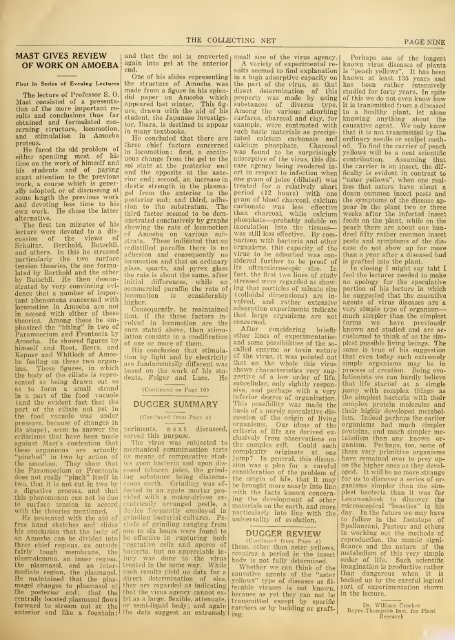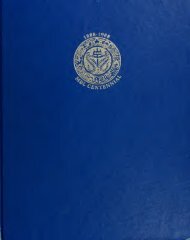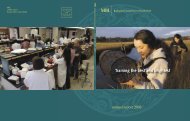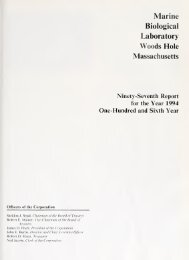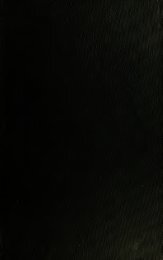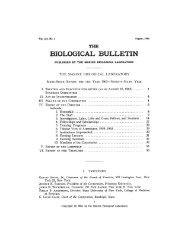View/Open - HPS Repository - Marine Biological Laboratory
View/Open - HPS Repository - Marine Biological Laboratory
View/Open - HPS Repository - Marine Biological Laboratory
- No tags were found...
Create successful ePaper yourself
Turn your PDF publications into a flip-book with our unique Google optimized e-Paper software.
——MAST GIVES REVIEWOF WORK ON AMOEBAFirst in Series of Evening LecturesThe lecture of Professor S. 0.Mast consisted of a presentationof the more important resultsand conclusions thus farobtained and formulated concerningstructure, locomotion,and stimulation in Amoebaproteus.He faced the old problem ofeither spending most of histime on the work of himself andhis students and of payingscant attention to the previouswork, a course which is generallyadopted, or of discussing atsome length the previous workand devoting less time to hisown work. He chose the latteralternative.The first ten minutes of hislecture were devoted to a discussionof the views ofSchultze. Berthold, Butschli,and others. In this he stressedparticularly the two surfacetension theories, the one formulatedby Berthold and the otherby Butschli. He then demonstratedby very convincing evidencethat a number of importantphenomena concerned withlocomotion in Amoeba are notin accord with either of thesetheories. Among these he emphasizedthe "biting" in two ofParamoecium and Frontonia byAmoeba. He showed figures byhimself and Root, Beers, andAmoe-Kepner and Whitlock ofba feeling on these two organims.These figures, in whichthe body of the ciliate is representedas being drawn out soas to form a small strandin a part of the food vacuole(and the evident fact that thepart of the ciliate not yet inthe food vacuole was underpressure, because of changes inits shape) , seem to answer thecriticisms that have been madeagainst Mast's contention thatthese organisms are actually"pinched" in two by action ofthe amoebae. They show thatthe Paramoecium or Frontoniadoes not really "pinch" itself intwo, that it is not cut in two bya digestive process, and thatthis phenomenon can not be dueto surface tension in accordwith the theories mentioned.He presented with the aid offree hand sketches and slideshis conclusion that the body ofan Amoeba can be divided intothree chief regions, an outsidefairly tough membrane, theplasmalemma, an inner region,the plasmasol. and an intermediateregion, the plasmagel.He maintained that the plasmagelchanges to plasmasol atthe posterior end ; that thecentrally located plasmasol flowsforward to stream out at theanterior end like a fountain:and that the sol is convertedagain into gel at the anteriorend.One of his slides representingthe structure of Amoeba wasmade from a figure in his splendidpaper on Amoeba whichappeared last winter. This figure,drawn with the aid of hisstudent, the Japanese investigator,Ibara, is destined to appearin many textbooks.He concluded that there arethree chief factors concernedin locomotion : first, a continuouschange from the gel to thesol state at the posterior endand the opposite at the anteriorend ; second, an increase inelastic strength in the plasmagelfrom the anterior to theposterior end; and third, adhesionto the substratum. Thethird factor seemed to be demonstratedconclusively by graphsshowing the rate of locomotioncf Amoeba on various substrata.These indicated that onredistilled paraffin there is noadhesion and consequently nolocomotion and that on ordinaryglass, quartz, and pyrex glassthe rate is about the same, afterinitial differences, while oncommercial paraffin the rate oflocomotion is considerablyhigher.Consequently, he maintainedthat, if the three factors involvedin locomotion are theones stated above, then stimulationconsists in a modificationof one or more of them.His conclusion that stimulationby light and by electricityare fundamentally different wasbased on the work of his students,Folger and Luce. He(Co;itinued on Page 10)DUGGER SUMMARY(CanSinuecl from Page 4)periments, next discussed,served this purpose.The virus was subjected tomechanical comminuation testsby means of comparative studiesupon bacteria and upon diseasedtobacco juice, the grindingsubstance being diatomaeeousearth. Grinding was effectedin an agate mortar providedwith a motor-driven exccntricallyarranged pestle, adevice frequently employed ingrinding bacterial cultures. Periodsof grinding ranging fromone to six hours were found tobe effective in rupturing both"•egetative cells and spores ofbacteria, but no appreciable injurywas done to the virustreated in the same way. Whilesuch results yield no data for adirect determination of size,they are regarded as indicatingthat the virus agency cannot existas a large, flexible, attenuate,or semi-liquid body; and againthe data suggest an extremelyTHE COLLECTING NETsmall size of the virus agency.A variety of experimental resultsseemed to find explanationin a high adsorptive capacity onthe part of the virus, so thatdirect determination of thisproperty was made by usingsubstances of diverse type.Among the various adsorbingsurfaces, charcoal and clay, forexample, were contrasted withsuch basic materials as precipitatedcalcium carbonate andcalcium phosphate. Charcoalwas found to be surprisinglyadsorptive of the virus, this diseaseagency being rendered inertin respect to infection whenone gram of juice (diluted) wastreated for a relatively shortperiod (12 hours) with onegram of blood charcoal, calciumcarbonate was less effectivethan charcoal, while calciumphosphate—^probably soluble oninoculation into the tissues^was still less effective. By comparisonwith bacteria and otherorganisms, this capacity of thevirus to be adsorbed was consideredfurther to be proof ofits ultramicroscopic size. Infact, the first two lines of studystressed were regarded as showingthat particles of minute size(colloidal dimensions) are involved,and rather extensiveadsorption experiments indicatethat large organisms are notconcerned.After considering brieflyother lines of experimentationand some possibilities of the socalledenzyme or toxin natureof the virus, it was pointed outthat on the whole this virusshows characteristics very suggestiveof a low order of life,subcellular, only sightly responsive,and perhaps with a veryinferior degree of organization.This possibility was made thebasis of a purely speculative discussionof the origin of livingorganisms. Our ideas of thecriteria of life are derived exclusivelyfrom observations onthe complex cell. Could suchcomplexity originate at onejump? In general, this discussionwas a plea for a carefulconsideration of the problem ofthe origin of life, that it maybe brought more nearly into linewith the facts known concerningthe development of othermaterials on the earth, and moreparticularly into line with theuniversality of evolution.DUGGER REVIEW(Continuprl from Pag-e 4)these, other than aster yellows,reauires a period in the insectbodv is not fully determined.Whether we can think of thecausative agents of the "asteryellows" type of diseases as filterableviruses is not known,because as yet they can not betransmitted except by specificcarriers or by budding or grafting.PAGE NINEPerhaps one of the longestknown virus diseases of plantsis "peach yellows". It has beenknown at least 135 years andhas been rather intensivelystudied for forty years. In spiteof this we do not even know howit is transmitted from a diseasedto a healthy plant, let aloneknowing anything about thecausative agent. We only knowthat it is not transmitted by theordinary needle or scalpel method.To find the carrier of peachyellows will be a neat scientificcontribution. Assuming thatthe carrier is an insect, the difficultyis evident in contrast to"aster yellows", when one realizesthat asters have about adozen common insect pests andthe symptoms of the disease appearin the plant two or threeweeks after the infected insectfeeds on the plant, while on thepeach there are about one hundredfiftyrather common insectthe dis-pests and symptoms ofease do not show up for morethan a year after a diseased budis grafted into the plant.In closing I might say taht Ifeel the lecturer needed to makeno apology for the speculativeportion of his lecture in whichhe suggested that the causativeagents of virus diseases are avery simple type of organismmuch simpler than the simplestforms we have previouslyknown and studied and are accustomedto think of as the simplestpossible living beings. Thesame is true of his suggestionthateven today such extremelysimple organisms may be inprocess of creation. Being evolutionistswe can hardly believethat life started at a simglejump with complex things asthe simplest bacteria with theircomplex protein molecules andtheir highly developed metabolism.Indeed perhaps the earlierorganisms had much simplerproteins, and much simpler metabolismthan any known organism.Perhaps, too, some ofthese very primitive organismshave remained over to prey uponthe higher ones as they developed.It will be no more strangefor us to discover a series of organismssimpler than the simplestbacteria than it v\'as forLeeuwenhoek to discover themicroscopical "beasties" in hisday. In the future we may haveto follow in the footsteps ofSpallanzani, Pasteur and othersin working out the methods ofreproduction, the cosmic significanceand the nature of themetabolism of this very simpleorder of life. Such scientificimagination is productive ratherthan dangerous when it isbacked up by the careful logical.sort of experimentation shownin the lecture.Dr. William CrockerBoyee-Thompson Inst, for PlantResearch


